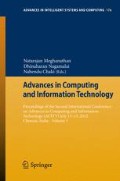Abstract
In this paper, we introduce the root of digital human binary coded Jong Nang communications as the wooden gate in Korea Jeju Island custom, has been using after about 1234 years. We compare the digital logic with modern traffic signal codes and analysis of both cases. Shannon channel capacity of the Jong Nang are 3 input NOR and binary erasure multiple access channel. Jong Nang communications is normal 3 rafters placed on two vertical stones with three holes to convey the family’s whereabouts that is deterministic signal, nowadays it is applied to backhaul in mobile base station.
This work was supported by WCU R32-2012-000-20014-0, FR2010-0020942, MED 2012- 002521, NRF, Korea and Hannam University while taking a sabbatical leave in SRM University, India.
Available on line: This work was partial introduced to KBS TV Broadcasting in Korea 27 Oct. 2011, also link to China network: http://v.youku.com/v_show/id_XMzE3NjMyNTky.html
Access this chapter
Tax calculation will be finalised at checkout
Purchases are for personal use only
Preview
Unable to display preview. Download preview PDF.
References
Heath, F.G.: Origins of the binary code. Scientific American 227, 76–83 (1972)
Aschoff, V.: The early history of the binary code. IEEE Communication Magazine, 4–10 (1983)
Lee, M.H.: Jong Nang. In: EXPO 1993 Information & Telecom. Pavilion poster (1993)
Cover, T.M., Thomas, J.A.: Elements of Information Theory. John Wiley & Sons, New York (1991)
Lee, M.H.: The History of Information and Communication. Kimyeong-Sa, Seoul (1994)
Lee, M.H.: Jong Nang: The symbol of digital communication and Ying and Yang. Telecom. 9(1) (1993)
Lee, M.H.: Jong Nang System. Patent, no. 133285 (1998)
Lee, M.H.: The History of Jeju Jong Nang Binary Code. IEEE VTS News 50(1) (2003)
Shannon, C.E.: A Mathematical Theory of Communication. Bell System Technical Journal 27, 379–423, 623–656 (1948)
Marseh, P., Fettweis, G.P.: Coordinated Multi-Point in Mobile Communications, ch. 12, pp. 277–310. Cambridge Press (2011)
Salman, A., Suhas, D., Tse, D.: A Deterministic approaches to wireless relay networks. In: ISIT (2007)
Author information
Authors and Affiliations
Corresponding author
Editor information
Editors and Affiliations
Rights and permissions
Copyright information
© 2012 Springer-Verlag Berlin Heidelberg
About this paper
Cite this paper
Lee, M.H., Ali Khan, M.H., Park, D. (2012). Jong Nang 3-Input NOR Channel,. In: Meghanathan, N., Nagamalai, D., Chaki, N. (eds) Advances in Computing and Information Technology. Advances in Intelligent Systems and Computing, vol 176. Springer, Berlin, Heidelberg. https://doi.org/10.1007/978-3-642-31513-8_57
Download citation
DOI: https://doi.org/10.1007/978-3-642-31513-8_57
Publisher Name: Springer, Berlin, Heidelberg
Print ISBN: 978-3-642-31512-1
Online ISBN: 978-3-642-31513-8
eBook Packages: EngineeringEngineering (R0)

